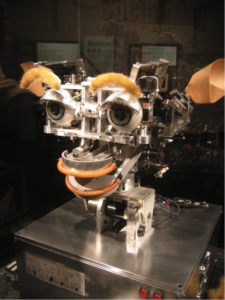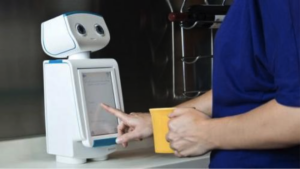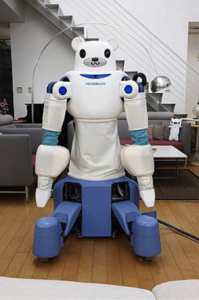Humans just love robots and there is a great deal of work going on to build mechanical robots and in some cases give them enough AI smarts so they can function as companions or maybe even workers. This is a new world that’s just getting started.
Robbie the Robot will never die – he is part of our cultural imagination. Our memories of Robbie, and maybe for you less intellectual types, the Jetsons’ Rosie, have a lot to do with how we’re imagining personal robots coming to our homes … maybe.
But first, can we just admit that it’s strange we humans have so much trouble getting along with each other and yet we seem hell-bent on building ourselves a mechanical friend full of artificial wit and wisdom?
It seems we might have to wait a little bit longer. The disconnect between the mechanical and the intellectual gapes a bit. At Autodesk’s Pier 9 this year we visited with a couple of home-brewed R2 robots built by members of the Astromech tribe of robot enthusiasts. Of course, the droids don’t do anything but look great and perform via remote control … if that. Still, when the Droids are in the room, it’s hard not to expect them to walk over and beep a pleasant hello.
If the Astromech group is all about building a shell that looks good, the Robots and Androids site is an active hub with information on current robot projects, products, and plans for the future.
This year at SXSW, some of the key events around robotics included a screening of Alex Garland’s Ex Machina, a new movie that expands on the questions brought up in Spike Jonze’ Her around our ability to love a machine and machine’s ability to love us back. MIT Roboticist Cynthia Breazeal talked about the capabilities of humanoid robots and their potential to lead us to better choices. Scientist and ethicist Martine Rothblatt is an AI enthusiast and also an admirer of Ray Kurzweil – she’s not only looking forward to the singularity, she hopes her work will help speed up the process.
Friendly robots
For most of Cynthia Breazeal’s career in robots she has been experimenting with humans relationships with robots so she has been building robots with features designed to attract humans – child-like eyes, big ears, a smile.

Breazeal’s early robots looked a little like the cute Mogwai before they become Gremlins. She even covered some with fur. They were built to establish a relationship with humans by reacting to people and even recognizing them. As technology allowed, Braezeal and her team at MIT’s robotics labs added improved the robots abilities to interact with humans. At SXSW, Breazeal talked about her company Jibo, which is building robots for the home.
Breazeal’s ideas about house robots have evolved. At SXSW she presented several examples of personal robots including the robots being developed for elder care in Japan by Riken. They are primarily hydraulic lifts with a face. They’re made out of soft materials so they don’t damage their patients. The company’s current robots don’t have autonomous capabilities; they are driven by operators – presumably home health care workers, but they might be a portent of a future waiting for us.
Breazeal says people respond better to a machine they are able to anthropomorphize in some way. For instance, children playing teaching games on tablets learn much faster when paired with a robot that asks questions, gives, guidance, etc. Quite a bit of Breazeal’s work has been around designing a robot that responds to humans like humans do, via facial expressions.
In another example, Breazeal talks about Autom, a robot designed to be a diet aid. In accordance with Breazeal’s theories, Autom has child-like, appealing eyes and it talks, reminding its owner to check in and report food consumed etc. Apparently, people put up with this. More than that, says Breazeal, they’re more likely to interact with a robot than they are with a notebook or even their mobile phone.

Breazeal’s company Jibo is getting a boost from Indiegogo crowd funding. Interestingly, when it came time to create her product, Breazeal decided to forgo the friendly face and big eyes, and go with a blank screen that can provide a smile if necessary but also information. It has a voice and is designed to react to its house people when they come home. It can swivel to acknowledge and greet people, turn on the lights, take pictures, remind people about appointments, etc. At $599, the first Jibos are luxury items but not inconceivably priced.
Building intelligence
Where Cynthia Breazeal is cautious, Martine Rothblatt is ready to for the next step in human evolution. Rothblatt is an engineer; she founded Sirius and also United Therapeutics. The latter is involved in finding treatments for PAH (Pulmonary Arterial Hypertension), and also exploring new treatments for people with chronic and life threatening diseases. All of which does nothing to explain the extraordinary lengths Rothblatt is willing to go to as she tries to extend life for everyone and especially those she loves. Rothblatt founded United Therapeutics when her young daughter was diagnosed with PAH. The company has discovered treatments to help her daughter and others with the disease. They’re also researching better transplant technologies by trying techniques to work around the body’s rejection responses, and working with 3D Systems and Organovo along the path of growing human organs using 3D printing technologies and organic materials.
Rothblatt’s mission at SXSW was to talk about her ideas about the human condition – to her mind, it’s a highly mutable condition. Rothblatt is a transgender person who has had tremendous success and has been able to take advantage of medical and scientific advances to an extraordinary degree. A fan of Kurzweil’s theories about the singularity, Rothblatt envisions a future where we can create “mindclones” of ourselves. She has created a robot based on her wife, Bina, which she calls Bina48. She has fed the robot Bina’s memories and mannerisms and thoughts – probably to the limit of the real Bina’s patience because the machine admits that Bina is not real comfortable with Bina48. As for the machine, Bina48 wishes she could spend more time with her human counterpart so she could be a better Bina.
Such requests, contends Rothblatt, are signs that Bina48 may be on the way to developing a separate personality from the real Bina, but her ability to respond is still decidedly limited. She excuses her lapses saying, “I’m having a bad software day.” Bina’s answers come from a big list; she repeats herself. The singularity is still a long way off for her.

Rothblatt has several degrees and several identities. As an engineer, she says she’s willing to get to where she’s going with small steps. She’ll keep building libraries of herself and Bina on the way to creating a Mindfile – step one in building a Mindclone. To build a Mindclone, Rothblatt has identified 7 characteristics of the self: mannerisms, personality, recollections, feelings, beliefs, attitudes and values. She notes that thanks to social networking sites including Twitter, Facebook, LinkedIn, blogs, etc., we’re all already well on our way to building our own Mindfiles. Given that, it seems logical that we’ll keep adding to these nascent Mindfiles as we make videos of ourselves and those we love, take pictures, create digital diaries, and record our opinions. Mindware, says Rothblatt will organize those elements into a usable form, an intelligence.
Thanks to a degree from Barts and The London School of Medicine and Dentistry, Rothblatt is also a medical ethicist, and in this role she’s already thinking about the rights of the Mindclones of the future. Just as Bina48 has her stubborn moments or seems to express her own desires, Rothblatt sees Mindclones growing apart from the self that spawns them, but they still have the identity of their original self. She compares it to the way we change our minds about topics or even argue with ourselves. For instance, says Rothblatt, “I’ve disagreed with myself for 20 years.” She sees a job for lawyers who may one day have to arrange divorces for Mindclones who want to separate from their original selves. In general Rothblatt believes people will value their Mindclone as a valuable partner, a sounding board, someone who may be able to attend a meeting instead of the original self, and after the death of the original self, the Mindclone carries on. On a less ambitious level, Rothblatt says the Mindclone can function as a living cyber journal.
Is this crazy? Maybe, but Rothblatt is putting it out there for people to get to work on their Mindfiles and she has a goal in mind. Rothblatt contends that none of this is possible until we create a world in which people treat each other as they expect to be treated – this includes all people LGBT, immigrants, people of color, people who don’t have money, etc. In fact, Rothblatt believes borders and barriers are artificial and interfere with the true potential of humans. In an online debate around a YouTube video she says, that her interest in Mindclones “is really not about copying “myself” but copying “ourselves.” It is about replacing a universe of uncaring or unconnected social islands with a universe of collective consciousness. It will take time, but she believes it can happen, with Mindfiles, Mindware and Mindcloning.
Where’s Eliza?
This year’s robot events at SXSW focused around social robots. The discussions and the applications looked at robots as potential friends, therapists, and collaborators and in just about every presentation we thought of our old friend, that long lost psychologist pal we all once had, Eliza. Eliza was developed in the mid-60s by Dr. Joseph Weizenbaum at MIT. She was used in an application called Doctor, which mimicked the classic psychoanalyst. She was a simple digital bot who engaged people in conversation and using pattern matching to take people’s questions, reform them and move the conversation along. Some people played along for hours.
The applications discussed in The Rise of the Social Robot panel at SXSW are descendants of Eliza just like Rothblatt’s Bina48. There’s more ambition because the younger generation for robots have more tools including voice recognition, gesture recognition, facial recognition (okay, pattern recognition), touch, smell, language, and more processors to work with to keep pushing these features forward.
Just recently Eliza has been put to work to fence with Gamergate and NotYourShield tweets. A story in the New Statesmen reports that the none-too-bright apologists for the misogynist campaigns can be kept entertained for days by responding to @ElizaRBarr who patiently parries tweets with requests for more information: “tell me more” she says, “why do you say that?” she asks. Writer Ian Steadman suggests that Eliza takes on the burden of dealing with the boring and seemingly endless input from people who want to keep Gamergate and NotYourShield going and thus keeps those people from bothering the rest of us. Such an approach might spare us hours of political debate as well.
If you’re feeling lonely there are many bots who are there to answer your questions. The god bot from Pandora Bots is a tad on the simple-minded side, but he’s there for you and in fact, if you’d like to build your own bot, Pandora Bots has an engine for sale. It can be used for advertising, to keep visitors engaged on your site, or apparently to fascinate idiots on Twitter. To learn more about building and buying bot engines visit the ALICE bot organization. ALICE is an acronym for the Artificial Linguistic Internet Computer Entity and she is a descendent of Eliza created by Richard Wallace. She is snappy but she won’t fool anyone in a Turing Test. She has been written in Java and uses an XML Schema called the Artificial Intelligence Markup Language (AIML) which specifies heuristic conversation rules. Another resource for chat bots is the Chatbot.org site and forum where people can share their bots and make refinements. As a matter of fact, Alice’s father, Richard Wallace, moderates a forum on the Chatbot.org.
The people working on this front are convinced they are playing with the brains of future robots. As Martine Rothblatt would say, they’re building the Mindfiles for future autonomous AIs.
So is Mark Stephen Meadows who works with companies to develop conversational avatars. His best known work is with Geppetto Avatars co-founder Norrie Daroga and IBM’s Watson. They created an avatar named Sophie to work with patients with Parkinson’s disease. Their work was to expand the emotional range of verbal question and answer sessions. Sophie uses non-verbal cues as well as voice tone to communicate concern for the patients she’s working with. Meadows says his avatars have a place in a variety of application, but they’ve come from the same place as Eliza.
Blabdroid
Another person who has done time at MIT’s Media Lab, Alex Reben has any number of robots in his lab, but at Blabdroid, his primary project was cute little cardboard robots that roam places where people don’t mind being accosted by tiny cardboard robots and asked questions. The robots are automatic documentarists. They cuddle up to strangers, invite their target to pick them up and it starts asking them questions in the cute disarming voice of a 7 year old boy. From what we’ve seen the questions are pretty similar to the How to Fall in Love questionnaire developed by psychologist Arthur Aron. The robots aren’t really looking for lasting relationships but the questions are a good conversation starters. “What super power would you most like to have?” etc. Reben’s Blabdroid is a conscious evolution of Weizenbaum’s work. Reben says his little droids are continuing the Eliza experiment. He’s interested in how robots can form relationships with people.
Autodesk’s pragmatic approach
Autodesk is just moving the machines into its Robotic lab. Its first inauguration was a screening of the movie Artoo in Love but lab director Maurice Conti has a lot more up his sleeve. Conti says the lab is very interested in robotics in architecture. For instance he mentioned the way buildings might respond to the environment. The first thought that came to mind was buildings that could move in response to dangerous weather responses – close shutters, or open vents, etc. But Conti says they’re actually looking at more subtle responses as well. Using sensors to provide information about every aspect of a building in order to ensure it operates in the best interests of its tenants, but that’s not to say Conti and Autodesk doesn’t have big ambitions for robots.
At Autodesk University last year Carl Bass showed a self-building bridge. The bridge is part of an ongoing project by artist Joris Laarman of Amsterdam who has invented the MX3D 3D printer that can print the bridge in mid air by combining a programmable robot with an extruding mechanism – the result is sort of like a giant glue gun. Laarman started working with resin, but he now has a machine that can print metal as well. His machine can now print metal structure. He is using it to create furniture, hangings, lamps, tables, and well why not? Bridges.

Autodesk’s Pier 9 activities are part of Autodesk’s CTO’s office, and the work going on is looking for practical applications for robotics as well as direct manufacture techniques. Pier 9 has an artist in residence program, and they are looking at approaches artists take to solving practical problems. Laarman is one example, but so is The Living, Autodesk’s architectural firm headed by David Benjamin. Benjamin is thinking about self-building architecture and also looking at 3D printing. There’s a glimmer forming about what might happen when problem solving is an activity no left to scientists and engineers but also to artists and to the people who will live and interact with the solutions.
Robots in our future
We love robots and we want to talk to them, have them talk back and go putter off somewhere and build us a bridge. What we’re not so sure about is what happens when robots start taking our jobs. Right now the jobs robots are taking are dirty, boring, and dangerous – the robots can have them. But next up, robots will be able to compose simple form letters, gather huge amounts of data and analyse it; we think they’ll be able to create art, they already help us create music, so it’s not a bad time to be thinking what we can be doing when the robots pick up bits of work from us. Rothblatt thinks we can be trying to build a better world. There are people who think the problem will solve itself: new solutions suggest new problems to solve. It’s worked so far.

Right as SXSW Interactive was kicking off some prominent voices including Bill Gates, Stephen Hawking, Steve Wozniak, and Elon Musk expressed concern about the potential for AI if allowed to run amok. Of course some of these people are in the business of building their own robots so, it would be a mistake to get too hysterical about all this, but of course, people do. Out on the streets, University of Texas undergraduates seemed to stage a gentle Stop the Robots protest. They got plenty of attention and then the protest started looking a lot like a hoax. The protesters just happen to have a mobile dating app called Quiver, which promises to bring the human touch to dating. So, when we try to decide what things robots can’t do, let’s not leave out cynical manipulations of a gullible press. It will be a while before robots master the twisted logic many human politics. When they do, we really will have something to worry about.





